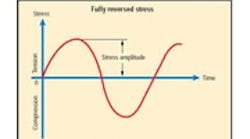In mechanical systems, numerous engineered components are subject to variable loading. Rotating shafts, for example, may undergo torque reversals or fluctuations. Furthermore, shafts often absorb high numbers of stress cycles through reversed bending. Here, a transverse load (perhaps from radial and tangential gear reactions or overhung loads) continues to act in one direction as the supporting shaft turns. The shaft’s axial fibers are thus forced to contend with both tension and compression during every revolution.
Fatigue will result from this kind of “everyday” dynamic loading. You don’t have to bombard a component with high shock loads for it to eventually fail. Years ago, mechanical engineers were at a loss to explain certain failures – for example, locomotive axles breaking. Even with large safety factors, though, their designs were based only around the static load, which was an incomplete evaluation of reality.
Much of the information about fatigue is based on empirical data. There are several approaches to describing it, but basically, localized plastic strain occurs at a point where stress is concentrated. This is typically at a geometric discontinuity such as a hole, a step in shaft diameter, or even a small surface anomaly. The low-level strain fluctuates with the load, perhaps thousands or millions of times, until a tiny crack develops. The crack eventually propagates to the point where the material abruptly gives way. Even highly ductile materials are prone to sudden catastrophic failure from fatigue.
Questions & answers
Q: How are fatigue properties represented?
A: A material may be described in terms of fatigue limit, the highest reversed-stress amplitude it can undergo without failure for an infinite number of cycles. (Many nonferrous metals have no fatigue limit, as they always fail eventually). Fatigue strength, on the other hand, refers to the level of reversed stress causing material failure at a specified number of cycles. Similarly, fatigue life is the number of reversal cycles to failure at a given stress. Such data is often seen on S-N (stress versus logarithmic number of cycles) curves. Laboratory-derived numbers usually require modification to account for less-thanoptimum circumstances.
Q: What are some ways to optimize fatigue resistance?
A: Fatigue nearly always begins with microscopic cracks at the surface, typically where there are sharp changes in geometry. These transitions should be rounded. Improving the surface finish removes tiny surface imperfections that are potential trouble spots. Surface hardening by mechanical, chemical, or heat processes can help stave off fatigue, instead of using a material that’s stronger (and more brittle) throughout. Certain metallic platings, on the other hand, can significantly reduce the fatigue strength of the part – zinc plating is an exception.
Q: What of environmental influence?
A: Corrosive surface damage decreases component fatigue life and makes the life extremely difficult to speculate. Fatigue strength varies with temperature in a manner similar to static tensile strength; at elevated temperatures these strengths generally go down. Significant fluctuations in temperature cause expansion and contraction that can lead to thermal fatigue even in static structural parts.

